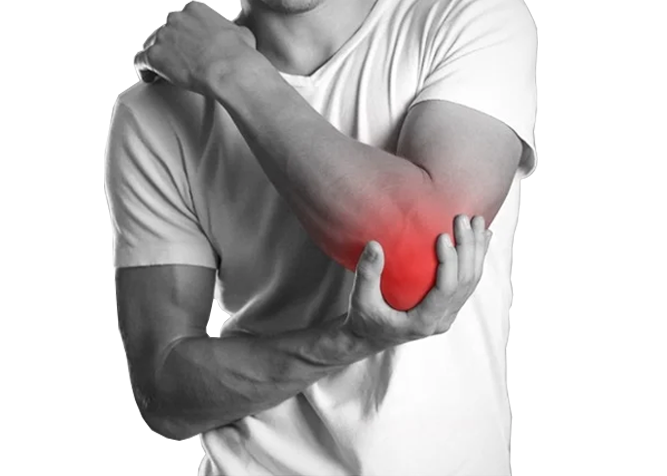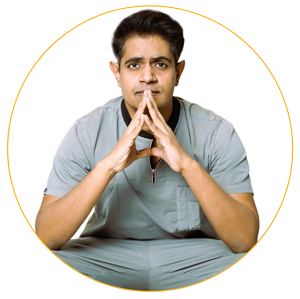Resistant Tennis Elbow
Radial Nerve Palsy
If you are on this page reading this, it means you have a chronic painful condition of the outer aspect of the elbow.

If you are on this page reading this, it means you have a chronic painful condition of the outer aspect of the elbow of your dominant working hand which has been earlier diagnosed by many physicians as Tennis Elbow and you have taken multiple treatments and therapies for the same but have no relief.
There might be a possibility that you are suffering from tennis elbow and is in the recovering phase which is quite long and can last up to one year during treatment for tennis elbow. If you have not felt any relief or have chronic pain in the elbow region and at the back of the upper part of the forearm since many years then you should read this page.
There is one more entity known as radial tunnel syndrome which is often confused with tennis elbow. It also gives rise to pain around the same region which is affected by tennis elbow but has a completely different etiology and management. That is why radial tunnel syndrome is often called as resistant tennis elbow.
Radial tunnel syndrome occurs when a nerve called as radial nerve is compressed as it enters the radial tunnel in the forearm.
The radial nerve is one of three nerves in your forearm, traveling from the side of your neck, down the back of your arm, through your forearm and into your hand. Your radial nerve is responsible for a lot of different arm movements, including forearm rotation, elbow straightening, and wrist and finger movements.
When the nerve reaches the elbow, it passes through the radial tunnel, which is a very narrow space surrounded by a lot of muscles. The nerve when compressed here often causes nagging pain in the upper part of the back of forearm.
Who is at risk of developing radial tunnel syndrome?
Radial tunnel syndrome is most common in women between the ages of 30 and 50 years.
- Men and women with poor forearm and wrist strength and flexibility.
- Sportsmen who fail to do warm up adequately before playing sports.
- Diabetes and Hypothroidism
- Tumors or ganglion cysts (mass or lump) in arm.
When radial nerve passes through the radial tunnel which is surrounded by muscles covered with fascia (tissue fibers that enclose, separate or bind together muscles and other soft structures), it becomes vulnerable to compression and irritation by the surrounding structures. If any of the structures becomes inflamed, it puts too much pressure on the nerve, leading to this condition. But there are several different activities that can cause radial tunnel syndrome, including:
- Repeating certain motions (often at work) over and over again. Typing or using a screwdriver are good examples of these types of motions.
- Constant push-and-pull activities like professional football or baseball players
- A direct Injury to the outside of elbow or forearm.
- Excessively gripping or bending wrist which places extreme tension in the muscles surrounding the radial tunnel.
Symptoms of Radial Tunnel Syndrome
- Profound nagging pain in the area on the outside of elbow, stretching down to the forearm which causes fatigue in the muscles while doing daily work. Pain may also get worse while sleeping. Certain activities can make these symptoms worse, including:
- Activities that require extensive use of your forearm and/or wrist.
- Twisting and turning motions of the wrist
- Lifting heavy objects
- Extending your elbow too much.
- Over time, radial tunnel syndrome can weaken muscles of the forearm and decreases wrist strength, making it increasingly difficult to grip or lift certain things.
- If unrelieved, it can cause wrist or finger, thumb drop, meaning you lose the ability to lift your hand or fingers and thumb from a drop position
Diagnosis of Radial Tunnel Syndrome
Radial tunnel syndrome is very frequently misdiagnosed as tennis elbow because of the same site of location of pain which also increases with twisting and turning movements of the wrist.
A careful history, proper physical examination can help in arriving at a diagnosis of radial tunnel syndrome.
The maximum pain in tennis elbow is at the region of the lateral epicondyle bone of the elbow region whereas in radial tunnel syndrome it is 2 to 3 centimetres distal to the bone.
The area can be examined for pain by applying light pressure and doing few provocative tests which can help in the diagnosis.
Pain while turning the palm up from a palm down position against resistance or pain while extension of the fingers against resistance is diagnostic of radial tunnel syndrome.
There are no formal imaging tests that can diagnose radial tunnel syndrome, though an X-ray, MRI or electromyography test, are done just to rule out other potential injuries or conditions.
Treatment of Radial Tunnel Syndrome
The goal of treatment is to eliminate pain and prevent it from ever coming back. Proven nonsurgical techniques exists which can benefit the condition of radial tunnel syndrome.
- Stop or reduce the activity or movements that causes pain.
- If your job is causing your symptoms, you may need to change your place of work or talk about getting more breaks during the workday.
- Try to avoid any heavy push-and-pull movements if possible.
- For athletes, practice strength and flexibility exercises and always remember to adequately warm-up before playing or practicing.
- Rest and medical treatment with anti-inflammatory medications is generally successful in relieving symptoms in three to six weeks for most patients.
- Steroid injections to relieve inflammation and pressure on the radial nerve, if necessary.
- Wearing a wrist and/or elbow splint to reduce movement and irritation
- Physical therapy exercises to help stretch out and loosen the tight muscle/tissue around the radial nerve (wrist extension stretch, wrist flexion stretch, wrist supination and radial nerve glide exercises).
If symptoms don't improve after nonsurgical treatment, then surgery is indicated which is done under brachial block or general anaesthesia. The goal of the surgical decompression is to take the unwanted pressure off the radial nerve as it passes through the radial tunnel. An incision is given right below the outside of the elbow and into the forearm. The area compressing the nerve is released, expanding the tunnel in the process.
After your surgery, you will be given an elbow splint that will immobilize your arm. Sutures are removed after 14 days. Around this time, you can also begin certain activities that will improve your range of motion, including:
- A gentle exercise program.
- Soft-tissue massages.
- Stretching.
Strength-building exercises for your forearm and hand, like squeezing rubber ball, under a therapist's supervision can be started 6 weeks after the surgery.
During this recovery phase, you need to avoid lifting and other activities that require you to bend your arm at the elbow.
In the final stage, exercises to stabilize and strengthen your wrist, elbow and shoulder will be added.
Recovery from this surgery takes about four to six months, but it can sometimes take even longer.
Late cases / Radial nerve Palsy
If the patient has presented very late, then it can lead to radial nerve palsy with atrophy of the muscles of back of forearm. He or she would be having permanent wrist, finger and thumb drop.
Such condition of wrist drop and finger, thumb drop (inability to extend the wrist, thumb and fingers) is usually seen in long standing compression of the radial nerves due to tumors or injuries of the radial nerve after accidents or fractures.
- If the radial nerve is found damaged, then surgical excision of the damaged part and nerve repair and grafting should be done with in 1 year of the injury
- If the patient has presented with sudden onset of paralysis of radial nerve, then other neurological causes or any nerve tumor should be investigated for.
- If the patient has presented late beyond the timing suitable for nerve repair (after 1 year of accident), then tendon transfers should be done to strengthen the weak portions of the hand. A strong tendon of the hand is re-routed to substitute a weaker or lost movement of the hand.
During tendon transfers for radial nerve palsy, 3 tendons from the front of the forearm and hand are taken, re-routed and sutured to the tendons of the back of the forearm and hand so that the patient can extend his wrist, fingers and thumb. The surgery is usually done under brachial block or general anaesthesia and a splint or slab is given for immobilization in the post operative period. The patient is usually discharged second day after the surgery. Sutures are removed 14 days after surgery.
Splint is removed 3 to 4 weeks after the surgery and gradual training of the transferred muscles or tendons is started so that they regain their newly assigned function.
Resistant Tennis Elbow / Radial Nerve Palsy Images
Indivisual results may vary from person to person.
These pictures are shown for the purpose of education only.


Know your surgeon better

Best plastic surgeon, Dr. Amit Agarwal is an American Board Certified, extensively trained, and best Plastic & Aesthetic surgeon in Lucknow. He is the Chief Plastic Surgeon heading the Department of Plastic, Microvascular, and Craniofacial surgery at Vivekananda Polyclinic and Institute of Medical Sciences, Lucknow, U.P, India. He maintains a busy practice at Avadh and Nishat Hospital and his own center - Kayakriti Plastic Surgery & Dental Center. He was formerly a Consultant in the Department of Plastic Surgery and Burns at the prestigious SGPGI, Lucknow.
MS, DNB (General Surgery) MCh, DNB (Plastic Surgery),
MNAMS, FACS, FICS, FRCS (Edinburgh, UK)
His Credentials
Three pillars of kayakriti
Privacy
We believe your experience with us should be comfortable and hassle-free to make it one of your best lifetime experiences for yours. We, here at the clinic, take full precautions to maintain your privacy in any manner. We also provide a staff who will receive you from the gate and take you to the chamber directly if you demand.
Trust
Our Surgeon is highly qualified and internationally certified with a team of skilled staff to perform any surgical or non-surgical treatment on your body.
Safety
When you plan to undergo any surgery you should always keep in mind that it's your body and it's a surgery. We, here always keep your safety a priority and will never recommend you to undergo any such procedure which is not safe for you. We also provide you with a detailed description of the complications which may occur after the surgery during the consultation as it's a surgical procedure so there may be some complications depending on the way your body reacts.
Kayakriti in news



Frequently Asked Questions
If you have flat or small breast and you want to improve your breast and hip contour ratio then you are a good candidate for it. The answer will be best provided after the first consultation with Dr Amit Agarwal.
Acute pain will be there for almost a week which gradually reduces and there will be soreness and swelling which may take up to 3 weeks to subside.
You can join your work and daily routines after a week of the procedure and can start exercising after 3 weeks of it.
Yes, you have to wear it round the clock unless we suggest you to remove it.
This surgery does not affect the ducts or the areas of the breast involved in milk production. Thus, it does not affect the breast feeding.
This surgery does not affect the ducts or the areas of the breast involved in milk production. Thus, it does not affect the breast feeding.












Kayakriti Plastic Surgery & Dental Center
D-43, Near Punjab National Bank, Rajajipuram, Lucknow, Uttar Pradesh - 226017, India
Phone No. +919695940009, +919695940006
Map Location





























Social Media Presence